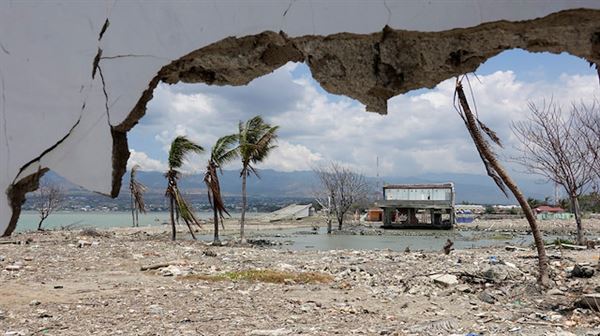Nearly a decade and a half ago, All eyes were on Aceh as a 9.3-magnitude earthquake and a tsunami towering nine meters high devastated the country's w
Nearly a decade and a half ago, All eyes were on Aceh as a 9.3-magnitude earthquake and a tsunami towering nine meters high devastated the country’s western coast on Dec. 26, 2004.
Based on figures from the International Federation of the Red Cross and Red Crescent Societies (IFRC), the disaster killed more than 220,000 people in 14 countries, including Thailand, India, Sri Lanka, Kenya, Yemen and Bangladesh.
As the world will observe the Tsunami Awareness Day next week, the Aceh region in Indonesia mourns the death of around 170,000 people.
Though devastated once by the 2004 tsunami, local disaster authorities warn that calamity may revisit the region.
Speaking to Anadolu Agency about the probability of happening similar natural disasters in the region, Chief of the Aceh Disaster Management Agency Sunawardi said the province is near active fault lines that could shift at any time to trigger an earthquake.
He said the capital of the province, Banda Aceh, is very prone to earthquakes as it is flanked by two active Sumatran faults: the Aceh and Seulimeum fault segments.
The agency recently released the Aceh Disaster Risk Assessment 2016-2020 report, which explained the tsunami risk in the area, mentioning that there were at least 11 regencies or cities that could potentially be affected by the tsunami.
“I can be sure that the entire Aceh region is prone to tsunami,” Sunawardi told Anadolu Agency in Banda Aceh.
He added that the Indonesian government had thus deployed Early Warning Systems (EWS) in 13 locations around Aceh.
The disaster agency has also distributed portable seismographs to actively monitor disasters in the region.
In 2016, Aceh was rocked by a 6.5-magnitude earthquake that killed 104 people.
Sunawardi said the agency was currently pushing for a law on disaster management education to be approved by the local House of Representatives.
This law aims to equip students with disaster knowledge and be able to adapt to large and sudden changes due to disasters.
“We want disaster education to be included in the school curriculum,” he said.
– Latest Findings
In August, the disaster agency presented the discovery of the 7,400-year-old Ek Luntie Cave in Lhoong District of Aceh Besar Regency, 50 kilometers (31 miles) from Banda Aceh.
The cave was discovered thanks to research conducted by a team from the Tsunami and Disaster Mitigation Research Center at Syiah Kuala University.
Ek Luntie — meaning bat nest in the local dialect — Cave holds traces of ancient tsunamis that happened in Aceh.
The scientists listed the tsunamis that hit Aceh by identifying deposited sand layers, determining the age of radioactive carbon and analyzing microscopic fossils or foraminifera.
Sunawardi said the research team found that over a span of the years 7,400-2,900 BC, two millennia had gone by without any tsunamis hitting the coast, but that there had been four tsunamis in 100 years around 1300 AD.
“Nobody can predict when a tsunami will hit again,” he said.
However, Sunawardi noted there have been 11 tsunamis in Aceh during the last 7,400 years.
“So, the possibility of a tsunami happening again is very big,” he said.
– Lack of early warning system
However, Tengku Yusri Sofyan, deputy head of Aceh Jaya Regency admitted that disaster mitigation has not been fully maximized in the region. Despite being one of the worst-affected areas by tsunamis, the area lacks an early warning system, according to him.
“We have a warning siren, but we also need EWS,” said Sofyan.
He said the people of his regency are alarmed by the tsunami risk as the memories have not faded even after 15 years have passed
In April, a 5.0-magnitude earthquake hit the Calang area of the Aceh Jaya regency.
According to the Indonesian Meteorology, Climatology and Geophysics Agency, the epicenter was 346 km (215 miles) southwest of Calang and 10 km (6.2 miles) deep.
Sofyan said the region still relied on sirens and information from the agency regarding earthquakes and tsunamis.
He said the government had provided residents with information about tsunamis, but that there were still many obstacles in operating the warning siren as it was still done manually.
“We need assistance for EWS to detect tsunamis,” he added.
– Lack of education
Syafruddin, 57, a fisherman who was a victim of the 2004 tsunami, complained about the lack of education about the disaster.
He said he had never received education on the EWS from the government.
Syafruddin urged the government to distribute EWS in the Aceh Jaya region, especially the Calang district, and to actively educate locals.
“So that we can get ourselves ready when a tsunami hit,” he said, adding that it was necessary to anticipate fatalities so disaster would not revisit the areas after 15 years.
Based on the IFRC report, a total of 19,661 people in the Aceh Jaya regency, including 5,000 from Calang district, died or disappeared after being hit by the massive tsunami in 2004.
Hoping that the tsunami would not hit Aceh again, he said the death of his wife and child continues to haunt him to this moment.
“I am still traumatized by the tsunami,” he added.
